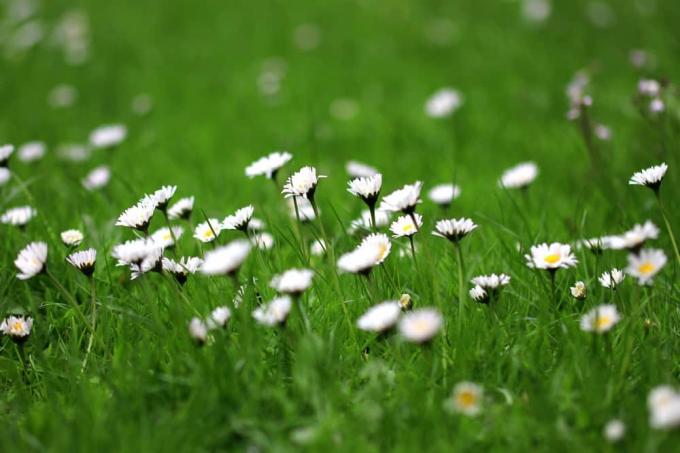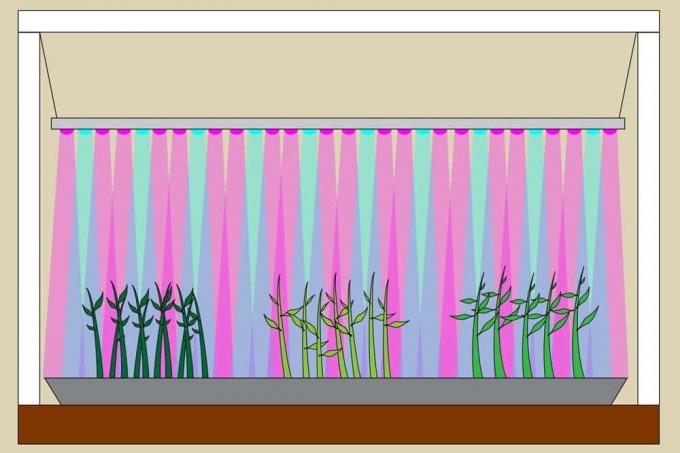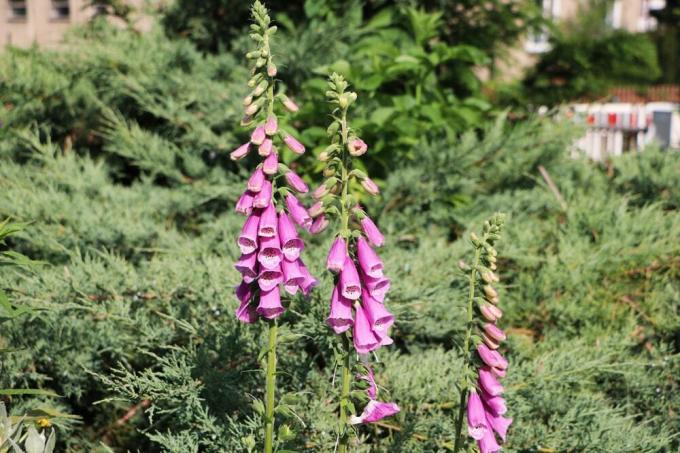

Table of contents
- Plants for the bedroom
- Palm trees in the bedroom
- Green plants for bright bedrooms
- Ferns for the bedroom
- All-rounder Ficus
- For dry climate
- Hydroponics as an alternative to soil
- frequently asked Questions
- Things to know about plants in bedrooms
All plants carry out photosynthesis. Under the influence of brightness, they absorb carbon dioxide from the air and excrete oxygen in return. Photosynthesis does not take place in the dark. Spent air is then not exchanged for oxygen-rich air. Plants absorb more oxygen at night. However, the value is so low that the air quality in the bedroom cannot be impaired. Contaminated potting soil is more likely to cause problems. Of particular concern are bacteria and mold spores in potting soil, which can trigger allergies. People with allergies should not put plants in the bedroom. For all others, plants improve the quality of life.
Plants for the bedroom
Apart from flowering plants, you can put any plants in the bedroom that can tolerate temperatures around 18 °C, because it is often cooler in the bedroom than in other rooms. Brightness also plays a role when choosing plants for the bedroom. You should avoid strongly scented plants as much as possible. The scent of flowers is a multiple trigger for morning headaches. However, green plants and palm trees are well suited for the bedroom. Palm trees are very decorative due to their imposing fronds. Leaf ornamental plants improve the air quality through more humidity. Plants that need a rest period in cool temperatures are also in good hands in the bedroom. Some species filter pollutants from the air that enter the air through carpets, tobacco smoke, or furniture. Spider plant and dragon tree filter formaldehyde from the air. Ivy can degrade benzene.
Palm trees in the bedroom
Palm trees spread a cozy Mediterranean atmosphere. The dwarf date palm is a real houseplant for the bedroom. It needs at least 16 °C room temperature and likes to be in the shade. The Livingstonia umbrella palm, on the other hand, can cope with 12 °C to 14 °C if it is placed in full sun. Despite its appearance, the dragon tree is not a palm tree, but one of the agave plants. It loves a light but not sunny location and temperatures around 18 °C all year round. the cycad, Cycas revolute, does well in a partially shaded spot and 15°C to 18°C. It also grows very slowly. For the phoenix palm, on the other hand, the bedroom is the right place to hibernate. It should hibernate at around 10 °C in winter. The yucca palm with its long sword-shaped leaves can stand cool all year round. It is particularly suitable for the bedroom.
Green plants for bright bedrooms
The Dieffenbachia does well in the bedroom if the watering rhythm is adapted to the cooler temperatures. Because the green plant does not like waterlogging. The foliage plant needs a bright and not sunny location. If you are looking for an unusual ornamental plant for your bedroom, then an indoor fir tree is an option. It tolerates the climate of cool rooms well.
Tip:
Turn the fir often so that it does not grow crooked.
Ferns for the bedroom
Ferns feel comfortable in high humidity. However, some types are also suitable for the bedroom. These species decorate the bedroom:
- Deer tongue fern for bright, cool rooms
- Shield fern for bright, cool rooms
- Rib fern for a partially shaded location
Tip:
If a fern requires high humidity, a humidifier can be set up in the vicinity.
All-rounder Ficus

The rubber tree also feels at home in bedrooms at home. The Ficus genus includes up to 800 species. Around 20 species are cultivated. Ficus species need a bright, but not sunny. Location and temperatures that do not fall below 15 °C. The rubber tree with pairs of oval leaves that can grow up to the ceiling is particularly widespread. The birch fig, Ficus benjamini, is particularly decorative due to its many small leaves. The birch fig grows bushy like a small tree and looks particularly filigree due to its many small leaves. These can be completely green or white bordered. Like a palm tree, the birch fig is a special eye-catcher in the bedroom. The Ficus pumila has a completely different growth form. Its shoots hang down like a waterfall from above. It is well suited for a hanging basket.
For dry climate
The aloe vera, which is known as a medicinal plant and acts as a moisturizer in many skin care products, likes a dry, cool climate in a location that is as bright and sunny as possible. The succulent green plant forms rosettes with its thick fleshy leaves. For the room, low species are particularly suitable, such as Aloe humilis with a wide variety of leaf shapes and colors or Aloe striata with striped leaves. Bow hemp is one of the agave plants. Also known as Sansiveria, it thrives best at room temperature. Its leaves grow upright and have a sword-like shape. The bow hemp is considered to be very robust and is well suited for beginners.
Hydroponics as an alternative to soil
Plants can be kept hydroponically in the bedroom to rule out health problems caused by potting soil. Many green plants and palm trees are suitable for hydroponics. In hydroponics, the plant substrate is set with a mineral substrate made of stones or expanded clay.
Tip:
Mineral substrates are heavier than expanded clay. They give the plant more support!
A hydroponic vessel always consists of two containers. The plant sits in the inner container. The water supply is stored in the outer container. Young plants tolerate a switch from soil to hydroponics better than older plants. Even palm trees, which are sensitive to care errors, often do better in hydroponics. By the way: Hydroponics does not produce fungi or harmful germs.
frequently asked Questions
Regular ventilation and sufficient brightness have a positive effect on the growth of green plants.
Yes, arch hemp, aloe, orchids and bromeliads produce fresh air and absorb carbon dioxide even at night.
Mold is caused by moisture. If the potting soil is moldy, plants should urgently be repotted and the plant pot replaced with a new planter. Drainage can prevent mold.
The plants do not need to be watered as often. This is particularly advantageous during the holiday season.
Things to know about plants in bedrooms
Basically, there is nothing wrong with palm trees and plants in the bedroom. The only problem is the potting soil represent. It is an ideal breeding ground for germs, fungi and bacteria. Mold formation and germs can lead to allergies under certain circumstances, so the potting soil poses a certain health risk. For this reason, allergy sufferers should generally avoid plants in the bedroom. Also flowering plants, which are very strongly scented can possibly cause headaches and are therefore not suitable for bedrooms.
- However, green plants can have a very positive effect on the indoor climate. Plants with large leaves in particular also humidify the air. This ensures optimal humidity and a healthy sleep.
- Furthermore, plants produce oxygen and thereby improve the air we breathe. Negative factors such as lack of oxygen and overheated rooms lead to dizziness, exhaustion and headaches.
- Bedrooms are the ideal location for many plants because it is cooler here. During dormant periods, a plant needs low temperatures and little water.
- Ideal bedroom plants are for example birch figs, yucca palms, yucca, silver fir and myrtle. But indoor ivy, climbing figs, Russian wine, indoor ferns and bobbed hair are also suitable for the bedroom.
Nevertheless, it is often not recommended to put plants and palm trees in the bedroom. green plants are generally harmless to health. Therefore, everyone should decide for themselves whether they want to do without plants in the bedroom or not.
In addition to the many positive properties indoor plants also for optical resting points in the living and sleeping area. This leads to increased well-being and more balance. Various scientific studies have been able to demonstrate the positive effects of indoor plants in rooms. For this purpose, the room temperature, humidity, noise and pollutant content in planted and unplanted rooms were measured. The studies have shown that plants have a particularly positive effect on the room climate and increase general well-being. The effectiveness of plants and palm trees should not be underestimated. They not only have a positive effect on living rooms and bedrooms, but also on classrooms and offices.
 garden editorial
garden editorial I write about everything that interests me in my garden.
Learn more about grooming

send plants | 7 tips for sending flowers
Sending plants requires good preparation. Not only the type of packaging is of great importance, so that the goods arrive safely at their destination. The season is also important. It depends on how well the plants survive the transport.

30 office plants for a better indoor climate
A bit of green in the office not only looks pretty, but can also significantly improve the indoor climate. For example, indoor plants increase humidity, can clean the air and, if they are large enough, even dampen noise.

21 edible flowers | What flowers can you eat?
Edible flowers can be used for many dishes in the kitchen, not just as decoration. The flavors range from sugary-sweet to peppery-spicy and give food and drinks a very special touch.

Everything about LED plant lights: Build plant lights yourself
Plants need light. In the absence of it, they suffer or perish. Sometimes, conventional daylight just isn't enough to meet a plant's light needs. Then LED plant lighting can help. How to build such a plant light yourself is here.

Shade plants: 17 green and flowering plants for the shade
Shady garden areas are a challenge for every hobby gardener, although shade does not mean that it is completely dark. Partial shadow and light shadow are also a type of shadow. The range of suitable plants is growing steadily and offers a variety of design options.

Forest flowers: 55 flowering species in the forest sorted by color
When the local forests dress in picturesque shades of color throughout the year, the numerous forest flowers in Germany present themselves and inspire with their blaze of colour. From purple to red to white and yellow, the German forests have a lot to offer.



